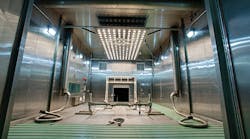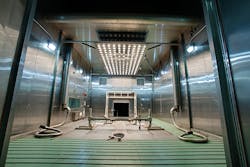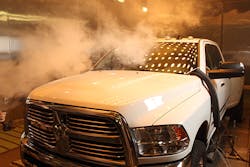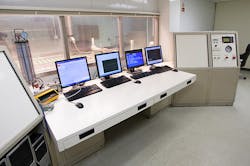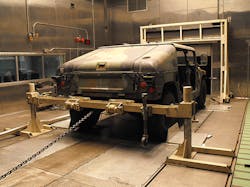Using Wind Tunnels to Simulate Weather for Product Testing
Wind tunnels aren’t just for testing aircraft anymore. Climatic wind tunnels, a variation on traditional wind tunnels, have been used by a host of large-scale manufacturers to thoroughly test components and finished products in the design and prototyping phases of product development, as well as troubleshoot finished products. These companies include manufacturers in the automotive, construction, agriculture, heavy duty trucking, and bus industries. Companies are now starting to similarly test small recreational vehicles such as ATVs and golf carts, as well as electric vehicles.
Over the last several years, companies, including T/CCI Manufacturing, a leading compressor manufacturer, have made significant investments in on-site climatic wind tunnels to test not only their products, but also let third parties purchase for wind-tunnel services to validate their designs in controlled environments.
Climatic Wind-Tunnel Advantages
Climatic wind tunnels are extremely useful for testing vehicles and parts in regards to air conditioning. It lets them repeatedly control a host of variables—temperature, humidity, wind flow and direction, and vehicle speed—that cannot be controlled outdoors, and lets them run extensive tests in different conditions. The wind tunnel’s realistic and repeatable conditions generate good data, which leads to objective analysis and evaluation, as well as good decisions when it comes to upgrading or changing designs.
“Our job is to make sure each part meets its performance goals,” says Dick Ennis, TCC/I director of engineering. “For example, we may be asked to test a radiator designed for trucks. The truck is designed by the manufacturer to pull a 5,000-lb trailer. They’ve done the research and narrowed their choices to three radiators; the first is a $100 component, and the team is confident it will meet performance goals. The others are at lower priced and it’s unclear if they can handle the job.”
All three components are taken into a climatic tunnel where a full-sized truck outfitted with the radiator being tested is simulating pulling a 5,000-lb trailer up a hill on a100° day with 40% humidity and full sunlight. The test is conducted in three different temperatures and on all three radiators.
Testing results show the $100 radiator ended up with a top water temperature of 200°; the $80 radiator did a fair job, but the unbiased test showed a 215° peak temperature; the $70 radiator hit 235°, causing the radiator to boil over and fail.
In another case, TCC/I used the wind tunnel to test an air conditioner. One goal it needed to meet was to continue cooling while the vehicle stood idle for 30 minutes. It couldn’t. There was a flaw in the design and our team had to add seals and making several other adjustments before it could.
Many vehicle manufacturers are concerned with fuel economy and improving performance, and tunnel testing can show the effects of various components and design approaches. It also lets them switch out components or assemblies and retest under the exact same conditions, making comparisons easy and straightforward. This is especially important when looking at variable and fixed-displacement compressors in the same cooling applications. The test shows how much each keeps cycling down to and the effects it has on the cooling performance of the systems.
“These are the kinds of questions we help get answers to with the wind tunnel,” says Ennis. “It lets manufacturers limit costly failures that lead to significant financial losses for operators.”
Climatic Wind-Tunnel Capabilities
Climatic wind tunnels have a variety of testing capabilities. For example, some, like T/CCI’s tunnel, provide stratified airflow. That means airflow is fully uniform from its originating point at the nozzle to the vehicle’s A-pillar around its windshield. This lets technicians accurately simulate the frontal airflow on a vehicle and its effects on the performance of various components as the truck is going down the road.
Some climatic wind tunnels let technicians determine the pressure setting at the front of the vehicle at ground level. They can also simulate heated roadways and generate valuable data for trucks and construction vehicles that spend their days working on hot asphalt. After all, asphalt can be 160° to 170° on hot summer days in many parts of the country. When a machine pulls onto a road that hot, it can cause problems that would put it out of commission.
Climatic testing is also valuable when designing for operator safety and comfort. Heater designs for example, are commonly put through rigorous performance testing to answer important questions. Can the heater warm up the cab after the vehicle has started and is running in a typical Midwestern winter between idle to 25 mph? And how long does it take until the cab is comfortable if it’s -20° outside?
“It’s doing your homework, plain and simple. The ultimate test is when the vehicle, tractor, or other final product goes to the customer,” says ICI senior engineering technician Matt Wilson. “Climatic wind tunnels are an efficient and cost-effective way to ensure everything is working as it should and as the customer expects it to. The ultimate fail is for the vehicle to go into production with an undersized radiator or cooling system.
“We also have customers come in with early prototypes, test them, and go back to the pinpointed flaws or issues and address the problems,” continues Wilson. “They come back for a second round of testing and, depending on what it is, sometimes come back four and five times to make sure the design is spot-on before they release the product to market.”
All manufacturers design for the worst case. With the climate, 98% of the time, heavy equipment and vehicles operate in relatively mild conditions, much milder than the climatic testing shows they can take, but they still need to be able to withstand the worst. Although the primary uses of climatic wind tunnels are for testing components and ensuring specific criteria are met, it is also how companies determine the warranty.
“The data derived from climatic wind-tunnel testing can help in developing warranty language and structure. If the warranty language is too close to the limitations of the system or vehicle, warranty costs could kill a manufacturer,” Ennis says. In addition, companies are able to avoid product recalls that could cost millions and cast a shadow over their reputation.
Climatic wind tunnels can also simulate the conditions that make thermal migration a problem, which often happens when a piece of equipment moves between extreme temperatures within a 12- to 24-hour period. For instance, a refrigerated trailer can be working during the day but sit all night, causing the refrigerant to move in and out of the compressor or turn from a gas to a liquid when it goes from hot days to cool nights. The effect on the compressor is dramatic. It can either wash the oil out of the compressor or significantly increase the liquid’s viscosity, so there are problems when the compressor is next turned on. If the tunnel reveals such a problem, engineers can take steps to alleviate them.
Emerging Markets
Climatic wind tunnels have been testing heating and cooling systems, radiators, and hydraulic pumps for heavy-duty vehicles and equipment. But the benefits of testing are now being explored by other industries that see value in the data. Climatic tunnels have tested the durability of wind turbines and solar panel, and the readiness of military personnel, rescue crews, and athletes.
In 2012, for example, the clothing maker Under Armour worked with the University of Maryland to manufacture custom-designed suits for speed skating. The suites were tested in an on-campus wind tunnel. “Anything with insulated properties can be tested and it makes sense. Clothing lines, wind resistant materials—these are all possibilities,” says Ennis.
In another instance, the tunnel was used to verify the claims of a company making a consumer product: patio umbrellas. They wanted to ensure their claim that the umbrella could withstand 30 mph winds without falling over. Thorough testing made sure they could confidently make that claim.
Companies of all kinds are also looking to sell their products globally. That means they must withstand and function in a host of different climates, some of them extreme.
Traffic lights and railroad equipment have to be able to keep from overheating in Phoenix in the hottest days of summer, and that same equipment could be used in Minnesota where it gets to -30° in the winter.
Climatic wind tunnels can simulate these drastically different conditions all in the same day. They can replicate the Sahara Desert for those that sell vehicles in Egypt, as well as the frigid extremes in parts of Canada or Russia. Modern climatic tunnels can simulate nearly every condition on Earth outside of the Arctic.
Wind tunnels are also being used to validate CFD models. Engineers are increasingly designing modeling product design and simulating their performance with CFD. But these simulations are theoretical ad cannot account in for all the actual variables, including weather and the environment. “Testing in a climatic wind tunnel lets companies confirm the level of design inexpensively so adjustments can be made outside of the virtual world,” Wilson adds.
